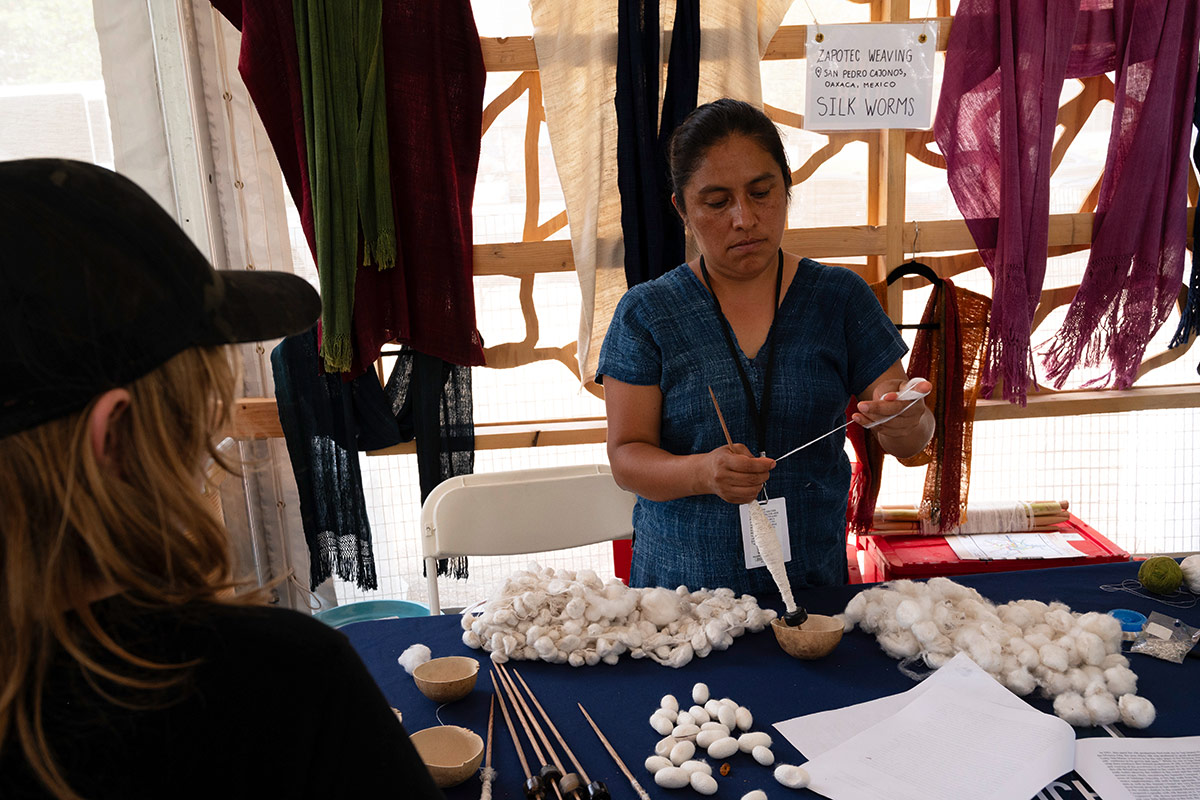“We Owe It to Our Grandmothers”: Zapotec Silk Traditions of Oaxaca

Gladys García shows Folklife Festival visitors the process of hand-spinning silk.
Photo by Sonya Pencheva, Ralph Rinzler Folklife Archives
“Silk? From Mexico?”
Many visitors were surprised as they admired a delicate white rebozo, a type of shawl, exhibited in the Zapotec Weaving tent in the 2024 Smithsonian Folklife Festival’s Indigenous Voices of the Americas program.
“A lot of people don’t know there are communities in Mexico creating beautiful silk textiles,” said Moisés Martínez, a member of Yagaa, a collective dedicated to growing and crafting silk pieces in San Pedro Cajonos, their hometown. Cajonos, a Zapotec community in the Villa Alta district of Oaxaca, is part of Mexico’s longstanding tradition of sericulture, or rearing silkworms for silk production.
Almost three hours from Oaxaca City, San Pedro Cajonos appears floating between clouds and mountains—yagaa means “mountain” in the Zapotec language. The community is surrounded by the Sierra Juarez of Oaxaca, which has evergreen pine forests and a subhumid climate. After the fall of Tenochtitlan, the capital of the Aztec empire, in 1521, artisans depended on the soil here, ideal for the emergence of an indigenous silk industry.
The first Bombyx mori, or silkworm eggs, were brought to New Spain in 1523. In their new home, a native mulberry, the morera criolla, served as an ideal food for the caterpillars. Around 1540, Dominican friars established missions in Oaxaca, including one in the Villa Alta district. Their presence led to the substantial rise of sericulture in the region. According to the Franciscan Toribio Paredes de Benavente, in 1541, Oaxaca produced 15,000 pounds of silk thread. By 1580, production grew to more than 20,000 pounds.



However, at the end of the sixteenth century, the silk industry collapsed due to two main factors. First, the mortandad, or loss of life, through epidemics and violence in the colonial period decimated the Indigenous populations. Meanwhile, the introduction by trade of Asian silks and Chinese damasks and satin replaced Indigenous silks. Nonetheless, the art of silk farming and weaving survived in some Indigenous villages in Oaxaca. San Pedro Cajonos is one of them. Of the thousands of people living in Cajonos, at least one hundred are involved in creating smooth and lustrous silks.
“The knowledge we have was passed down the generations,” shared Gladys García, another member of the Yagaa collective at the Festival. “We owe it to our grandmothers. They taught us how to take care of silkworms and transform silk into textiles.”
Since it started in 2018, Yagaa has aimed to protect locally raised silkworms (known as criollos, after their meal of choice) and preserve and expand their ancestors’ knowledge. Currently, ten women and five men belong to the collective and work on different tasks. “We have learned about agriculture, administration, marketing, design, chemistry,” García continued. “All these disciplines are necessary to develop artisanal work in a globalized world.”
Silkworm rearing is arduous and time-consuming labor. People prune the 2,000 mulberry bushes that grow in San Pedro Cajonos every August. Six months later, the moreras have enough leaves to feed the voracious silkworms. Silkworms are born in two seasons: spring and summer. From their hatching and for twenty-five days of growth, Cajonos’ inhabitants treat them lovingly.
“We adopt the silkworms as part of our family,” Martínez explains in an interview with Ivette Morán. “I say we adopt them because sometimes we have them in our kitchen or our bedroom. We live together. That’s what makes our silk different. We are not an industry where silkworms live isolated.”



After four weeks, silkworms weave their cocoons. They respect the silkworm’s life cycle during this period, García stresses. “We wait another fifteen days until they become a butterfly and fly away to transform their cocoons into thread and later into textiles.” In almost every other silkmaking tradition in the world, the larvae are killed in the process.
Yagaa members are experts not only in silkworm farming. They are masters in weaving beautiful traditional pieces such as rebozos and huipiles, a type of tunic used by diverse Indigenous populations since pre-Columbian times, as well as recent additions like scarves and jewelry made from silk threads.
“When Yagaa members started working together, we rescued traditional dyeing techniques,” García says. “We want sustainable products.” From weaving to dying a textile, the process takes several days, and sometimes months, depending on the complexity of the pieces.
Yagaa faces different challenges daily during their work. There are not enough resources to grow the number of mulberry bushes necessary to feed the silkworms grown in San Pedro Cajonos. Global warming has also affected Cajonos’ landscape, making it challenging to have ripe mulberry leaves in spring.
Despite these difficulties, Yagaa continues flourishing. Since 2020, they have worked in the El Santuario de la Seda installations, a space built for silk artists from San Pedro Cajonos. There—and at the Folklife Festival, and wherever the team travels—the Yagaa collective welcomes visitors who want to learn about an art that has been alive for almost 500 years.



Sitalin Sánchez is a Smithsonian Folklife Festival intern in the Indigenous Latinx specialization. She is a Nahua artist and research assistant at the Moses Mesoamerican Archive and Research Project.
References
Gracie, Leslie, “460 years of Silk in Oaxaca,” Textile Society of America Symposium: University of Nebraska, Lincoln, 2004.
Toussaint, Antonio. 1966. “Los conventos dominicanos del siglo XVI en el Estado de Oaxaca.” Artes de México, no. 86/87: 11–13.

